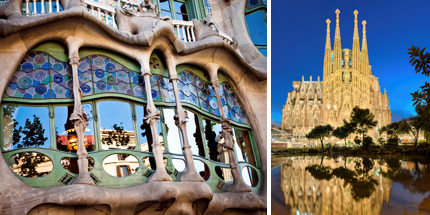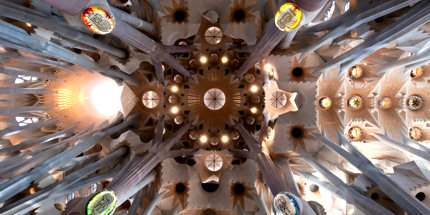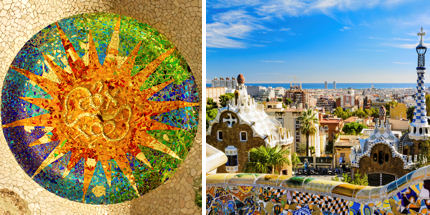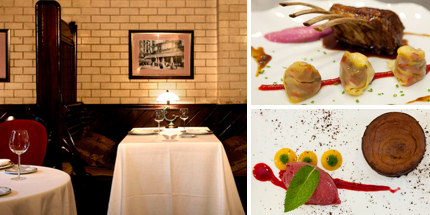Gaudí’s Barcelona
Antoni Gaudí’s beautification of Barcelona earned him the moniker ‘God’s architect’, but his masterpiece remains unfinished after 130 years in the making. Gavin Haines finds out why on a Gaudí-themed tour of the city.
The masterpiece
Like a supermodel with her hair in rollers, there’s an unfinished beauty about La Sagrada Família, Carrer de Mallorca 401 (tel: 93 207 3031). Shrouded in scaffolding and partially hidden by dust sheets, Gaudí’s incomplete symphony is, nonetheless, lauded as the most extraordinary example of Gothic architecture in the world.
Along with his other works, it has been awarded UNESCO World Heritage site status, although it still makes for a rubbish photograph; all my pictures of the basilica are ruined by cranes and other construction paraphernalia.
Incredibly, it is 130 years since Gaudí was commissioned to build this towering monument to Catholicism, and there’s still another 13 years until it will be finished – the basilica is scheduled for completion in 2026 to coincide with the centennial of Gaudí’s death.
 Casa Batlló and La Sagrada Família are two of Gaudí's most famous works
Casa Batlló and La Sagrada Família are two of Gaudí's most famous worksiStockphoto / Thinkstock
The project was bequeathed to Gaudí’s associate, Domènec Sugrañes i Gras, who encountered even bigger problems in 1936 with the outbreak of the Spanish Civil War. “Revolutionaries set fire to La Sagrada Família destroying the crypt, the workshop and Gaudí’s drawings for the building,” explains my guide, Maria.
That was a devastating blow for the basilica, but after a three-year hiatus, construction restarted in 1939 and hasn’t stopped since. Progress has been slow, but that’s to be expected from a project funded by private donations and ticket revenues (entrance fees start at €14.80).
Property porn
If you can’t afford a ticket for La Sagrada Família then you really should consider begging, borrowing or pickpocketing (a thriving industry here in Barcelona), because the basilica’s interior is a place of extraordinary beauty.
Forget anything you have ever seen in another Catholic church because this tears up the rule book. Spurning conventional engineering wisdom, Gaudí has designed the basilica’s pillars to mimic tree trunks; rising from the floor, these eccentric stone columns split into branches as they climb towards a ceiling, which looks as though you’re viewing it through a kaleidoscope.
 The basilica's interior is a place of extraordinary beauty
The basilica's interior is a place of extraordinary beautyiStockphoto / Thinkstock
Although Gaudí’s career culminated with La Sagrada Família, his portfolio of property is scattered across the city, and Casa Batlló, Passeig de Gràcia 43 (tel: 93 216 0306), is one of his most notable works. A masterstroke of modernism, this residential building was actually a renovation project for Gaudí, who transformed it from a prosaic apartment block into one of the most popular attractions in Catalonia. Incredibly, people still live here.
This fairy-tale building features an arched roof with scale-shaped tiles, which is said to represent the dragon slayed by St George, who is the patron saint of Catalonia. The intricate interior is just as impressive, and the audio tour gives you a comprehensive insight into the level of detail lavished upon this building.
The Gaudí trail
It’s easy to get hooked on Gaudí and I soon find myself tearing around Barcelona looking for my next architectural hit. But a Gaudí habit is also expensive; entrance to the Casa Batlló is an eye-watering €20.35, and although it’s worth the cash, you’ll spend a fortune if you want to visit all his buildings. And because they have different owners, there are no combo tickets that allow entry to multiple Gaudí buildings.
My advice, then, is to splash the cash at La Sagrada Família and Casa Batlló before swinging by to Park Güell, Carrer d'Olot (tel: 93 409 1831), a free-to-enter garden complex which is dripping with Gaudí’s work including the famous dragon fountain at the entrance. During peak season (from late March to late October), the park opens until 9.30pm and there is a beautiful terraced area that’s perfect for quaffing wine and watching the sun go down on Barcelona.
 Park Güell is a free-to-enter garden complex dripping with Gaudí’s work
Park Güell is a free-to-enter garden complex dripping with Gaudí’s workiStockphoto / Thinkstock
The bus takes passengers around Barcelona’s other architectural gems including the Olympic Stadium, which hosted the 1992 Games and ignited global interest in the city of Barcelona and subsequently the work of Gaudí. Other stops include the tree-lined La Rambla, a bustling tourist trap of legendary proportions that’s lined with bars, theatres and restaurants. The bus also stops at the Camp Nou, Avinguda Arístides Maillol (tel: 902 189 900), home of FC Barcelona and the theatre for some of the greatest football ever played.
Post modernism
At the end of a day spent gorging on modernist architecture (a time I like to refer to as ‘post modernism’), I imbibe Barcelona’s culinary offerings. Compared to Gaudí’s more famous works, Casa Calvet, Casp 48 (tel: 93 412 4012) – located in the Eixample district of Barcelona – is decidedly conventional, but for foodies this former merchant’s house warrants a visit. Originally built for a textile manufacturer, the building has been converted into a marvellous little restaurant that serves excellent food in elaborate surrounds.
 Casa Calvet serves excellent food in elaborate surrounds
Casa Calvet serves excellent food in elaborate surroundsCasa Calvet
If you’re looking to party, time your visit to coincide with the Festa de la Mercè, an annual carnival that swings into town on 20 September. Flotillas, fireworks and all-night street parties will make this event more gregarious than a Gaudí facade.
-------------------------------------------------------------------------------------
NEED TO KNOW
Getting there: A number of airlines fly to Barcelona from the UK, including easyJet which has six daily flights between London Gatwick and Barcelona.
Where to stay: The boutique Primero Primera, Carrer Doctor Carulla 25-29 (tel: 93 417 5600) is a gorgeous, family-run hotel with cavernous rooms, a delicious buffet breakfast and a peaceful location in Barcelona’s Les Tres Torres neighbourhood. Standard double rooms for September start from around €190 per night.
Do you have any Feedback about this page?
© 2025 Columbus Travel Media Ltd. All rights reserved. No part of this site may be reproduced without our written permission, click here for information on Columbus Content Solutions.









 You know where
You know where